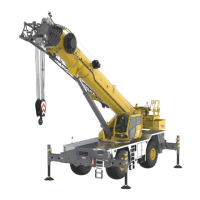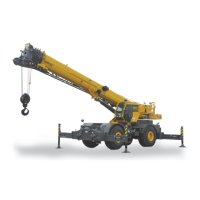ELECTRICAL SYSTEM GRT8100 SERVICE MANUAL
3-14
Published 3/26/2018, Control # 596-05
Alternator/Charging System
Troubleshooting
Test batteries, alternator, and cables any time there is a
problem with the charging system.
Required Tools
The following tools are required to diagnose the charging
system:
Visual Check
• Belts: tight, in good condition, not frayed, cracked or
glazed.
• Pulley: tight, aligned with other pulleys, not glazed.
• Alternator mounting bolts and wiring connections: clean
and tight, no signs of heat damage.
• Batteries: terminals and cables, clean and tight, no
corrosion or signs of heat damage.
• Check alternator fuse if Alternator Charge Lamp is
illuminated on the steering column display while engine
is running.
Engine Off Tests
Batteries
Disconnect batteries and test each battery individually.
Check electrolyte level if possible.
Using a multimeter, measure voltage across terminals. If
should read 130 A to 135 A.
NOTE: If correct readings were not obtained in the Engine
On Tests, perform the following two tests.
Voltage Drop Test
Positive Side
1. Set multimeter to the 2 volt range.
2. Connect positive (
+) lead to alternator output terminal
and negative (
–) lead to battery positive terminal or post.
Do not connect meter to battery cable.
3. Run engine at 2000 rpm.
4. Load system with carbon pile load or lights and heater
blower.
Allowable drop is 0.2 to 0.5 volts. Higher voltage drop
indicates loose, corroded, or broken connections.
Negative Side
1. Set multimeter to 2 volt range.
2. Connect negative (
–) lead to alternator case and positive
(
+) lead to battery negative terminal or post. Do not
connect meter to battery cable.
3. Run engine at 2000 RPM.
4. Load system with carbon pile load, or lights and heater
blower.
Allowable drop is 0.1 to 0.3 volts. Higher voltage drop
indicates loose, corroded, or broken connections. If any
voltage drop is greater than the normal range, troubleshoot
system and repair any problems.
After correcting any problems, perform Engine On Tests
again. If satisfactory results are not obtained, remove
alternator and bench test.
Replace Alternator
Removal
1. Ensure key switch has been in the OFF position for 2
minutes.
2. Turn battery disconnect switch to OFF position.
3. Remove ECM power fuse.
4. Remove negative battery cables.
5. Open engine compartment.
6. Tag and disconnect electrical leads from alternator
terminals.
7. Using a 1/2 in drive bar/ratchet, turn tensioner below the
alternator clockwise to remove belt tension. Slip belt off
alternator pulley. Let tensioner return to its normal
position.
8. Remove alternator mounting capscrews and alternator.
Equipment Example
Manitowoc
Part No.
Digital Multimeter Fluke
® 177 9999101763
Carbon Pile Load
Tes te r
Autometer
® SB5 9999101765
Current Clamp
Meter
Fluke
® 336 9999101764
DANGER
Do not smoke or allow sparks or open flame near
batteries, they can explode.
When working with batteries always wear protective
clothing, gloves and eye protection. Batteries contain
corrosive liquids that can burn skin and eyes and
destroy clothing.
Remove rings, watches or other jewelry before working
with batteries. A battery can produce a short-circuit
current high enough to weld a ring or similar to metal
causing severe burns

